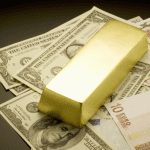This one seems like a no-brainer. The government or the central bank prints more bonds, notes and bills, and prices for things go up in response. Gold is real money, so it must fluctuate along with the inflation rate. It’s basic physics but it doesn’t happen that way. Let’s examine the history of inflation and the precious metals since the low of the Great Depression.
bonds, notes and bills, and prices for things go up in response. Gold is real money, so it must fluctuate along with the inflation rate. It’s basic physics but it doesn’t happen that way. Let’s examine the history of inflation and the precious metals since the low of the Great Depression.
 bonds, notes and bills, and prices for things go up in response. Gold is real money, so it must fluctuate along with the inflation rate. It’s basic physics but it doesn’t happen that way. Let’s examine the history of inflation and the precious metals since the low of the Great Depression.
bonds, notes and bills, and prices for things go up in response. Gold is real money, so it must fluctuate along with the inflation rate. It’s basic physics but it doesn’t happen that way. Let’s examine the history of inflation and the precious metals since the low of the Great Depression. By Vadim Pokhlebkin/Robert Prechter (elliottwave.com) originally* entitled Don’t Get Ruined by These 10 Popular Investment Myths.
Inflation occurred relentlessly from 1933 to 1970, yet gold and silver remained unchanged over the entire time. True, the government fixed the price, but markets are more powerful than any government, and if the market had wanted precious metals prices higher, it would have made them go higher.
The government still fixes the price of gold. The official, legal price today is $42.22 per ounce. If you were to ship gold overseas, and it got lost, a domestic insurer would have to pay you only $42.22 per ounce to cover it.
Investors in 1970 began forcing gold beyond the official price. They could just as well have done so anytime between 1933 and 1970, but they didn’t. Had you held gold for that period, you would have held the worst investment on the board. Investors in the stock market were making 20 times their money through capital gains alone and 30 times their money assuming a 4% (non-reinvested) dividend. Bond investors made nearly as much money through compound interest yet your investment — based on one-to-one, mechanical causality — was dead in the water.
Inflation continued from 1970 to 1980, and gold and silver soared. Inflation was all in the news, so people credited inflation for making these prices rise. They also predicted that the rise would not stop, because inflation was not going to stop. They were right about the inflation part.
Inflation continued from January 1980 to April 2001, too, but gold and silver lost 83% of their combined value during these 21 years, as shown in Figure 19.

Investors who held these precious metals during that time were once again stuck in the worst investment available but, this time, it was far more devastating. It was the only major investment that lost dollar value during those decades. Real estate went up, stocks went up, and bonds had a positive return. At the end of this period,
- a basketful of gold and silver was worth 17 cents, in inflated-dollar terms, for each full dollar that it was worth in January 1980. In terms of CPI purchasing power, the value of this investment fell to about six pennies per 1980 dollar.
- Stock prices, over the same period, rose 13 times in terms of dollars and 45 times in terms of gold.
Inflation continued from 2001 forward, and gold and silver rose four-fold into 2008-2009, so for eight years, this investment was once again profitable. Thus, out of a total history of 76 years of inflation, gold and silver rose for 18 of them. For 58 of those years, they went sideways or down…
[The above article is presented by Lorimer Wilson, editor of www.munKNEE.com and www.FinancialArticleSummariesToday.com and the FREE Market Intelligence Report newsletter (sample here – register here) and may have been edited ([ ]), abridged (…) and/or reformatted (some sub-titles and bold/italics emphases) for the sake of clarity and brevity to ensure a fast and easy read. The author’s views and conclusions are unaltered and no personal comments have been included to maintain the integrity of the original article. This paragraph must be included in any article re-posting to avoid copyright infringement.]
*http://www.elliottwave.com/freeupdates/archives/2014/10/28/Don-t-Get-Ruined-by-These-10-Popular-Investment-Myths-%28Part-IX%29.aspx#axzz3IOE2gK92 (© 2014 Elliott Wave International)
If you liked this article then “Follow the munKNEE” & get each new post via
- Our Newsletter (sample here)
- Twitter (#munknee)
Related Articles:
Most economists (primarily Keynesians and monetarists) believe that authorities can control the money supply and interest rates, and most neo-Austrians believe that the Fed is all-powerful when it comes to inflating – that whatever inflation rate it wants, it simply manufactures. Is that true or false? Read on for the answer. Read More »
It seems logical that a scary, destructive terrorist attack, particularly one that implies more attacks to come, would be bearish for stock prices – but has that actually been the case? Read More »
It would seem logical to say that peace allows companies to focus on manufacturing goods, providing services, innovation and competition, all of which helps the overall economy but does peace, in fact, have anything to do with determining stock prices? Read More »
A sensible story of causation regarding oil prices and stock prices made by countless economists is that “rising oil prices increase the cost of energy and therefore reduce corporate profits and consumers’ spending power, thus putting drags on stock prices and the economy.” Stunningly, as far as I can determine, however, no evidence supports that claim, as the discussion below will show. Read More »
Q: Is it correct to assume throughout that an expanding trade deficit impacts the economy negatively? A: No, the relationship, if there is one, is that there has been a positive — not negative — correlation between the stock market and the trade deficit. Let me explain. Read More »
The belief that earnings drive stock prices powers the bulk of the research on Wall Street but this glaring exception to the idea of a causal relationship between corporate earnings and stock prices challenges that theory. Let me explain. Read More »
It is common for economists to offer a forecast for the stock market yet add a caveat to the effect that “If a war shock or terrorist attack occurs, then I would have to modify my outlook.” As such, it would seem logical to assume that…they must have access to a study showing that such events affect the stock market, right? The answer is no, for the same reason that they do not check relationships between interest rates, oil prices or the trade balance and the stock market. The causality just seems too sensible to doubt. Read More »
Macroeconomic news supposedly explains only about one fifth of the movement in stock prices but if there is no accommodating theory, then the presumed causality involved is tenuous at best. Let me explain. Read More »
Events and conditions do not make investors behave in any particular way that can be identified as shown in this analysis of the supposed relationship between interest rates and stock prices. So much for the popular claim that “Interest rates drive stock prices”! Read More »
 munKNEE.com Your Key to Making Money
munKNEE.com Your Key to Making Money


